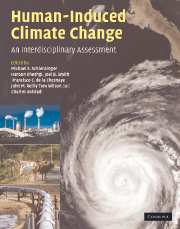Book contents
- Frontmatter
- Contents
- List of contributors
- Preface
- Part I Climate system science
- Part II Impacts and adaptation
- 9 Dynamic forecasts of the sectoral impacts of climate change
- 10 Assessing impacts and responses to global-mean sea-level rise
- 11 Developments in health models for integrated assessments
- 12 The impact of climate change on tourism and recreation
- 13 Using adaptive capacity to gain access to the decision-intensive ministries
- 14 The impacts of climate change on Africa
- Part III Mitigation of greenhouse gases
- Part IV Policy design and decisionmaking under uncertainty
- Index
- Plate section
- References
9 - Dynamic forecasts of the sectoral impacts of climate change
from Part II - Impacts and adaptation
Published online by Cambridge University Press: 06 December 2010
- Frontmatter
- Contents
- List of contributors
- Preface
- Part I Climate system science
- Part II Impacts and adaptation
- 9 Dynamic forecasts of the sectoral impacts of climate change
- 10 Assessing impacts and responses to global-mean sea-level rise
- 11 Developments in health models for integrated assessments
- 12 The impact of climate change on tourism and recreation
- 13 Using adaptive capacity to gain access to the decision-intensive ministries
- 14 The impacts of climate change on Africa
- Part III Mitigation of greenhouse gases
- Part IV Policy design and decisionmaking under uncertainty
- Index
- Plate section
- References
Summary
Introduction
It is well documented that the increasing levels of carbon dioxide and other greenhouse gases are likely to change future climates across the planet (IPCC, 2001a). The Third Assessment Report (TAR) of the Intergovernmental Panel on Climate Change (IPCC) has synthesized many studies describing the qualitative market and non-market impacts of climate change (IPCC, 2001b). However, quantitative estimates of impacts are rare. Most economic impact analyses of climate have focused on comparative equilibrium analyses. They have explored the difference between current conditions and what would occur if greenhouse gases doubled (see Pearce et al., 1996). Economists have rarely tackled the more difficult task of forecasting how impacts might unfold over the century. In this paper, we combine the power of the most sophisticated climate models with recent economic research to predict the path of climate impacts over time.
The modeling begins with forecasts of greenhouse gas emissions in the absence of mitigation. These emissions, in turn, lead to projections of increasing greenhouse gas concentrations in the atmosphere (IPCC, 2001a). We then use the climate predictions of six dynamic atmosphere–ocean general circulation models (AOGCMs) based on these concentrations. We combine these forecasts with two climate response functions: a relatively pessimistic experimental and a relatively optimistic cross-sectional model (Mendelsohn and Schlesinger, 1999; Mendelsohn and Neumann 1999; Mendelsohn, 2001).
- Type
- Chapter
- Information
- Human-Induced Climate ChangeAn Interdisciplinary Assessment, pp. 107 - 118Publisher: Cambridge University PressPrint publication year: 2007
References
- 2
- Cited by



